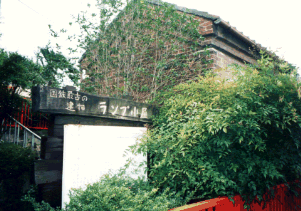JR Inari station was originally a station on the railway linking Kyoto and Otsu of Shiga prefecture that was opened to traffic.
As part of the Kansai Region railway development, Kobe and Osaka was opened to traffic in 1874 AD, and was subsequently
extended the east, connecting Kobe and Kyoto in 1877 AD. Until then, these huge public works were developed under the supervision
of foreign engineers. This was the first work developed entirely by the Japanese engineers, and this railway technology history
was an event worthy of special mention. There were many difficult construction zones such as the slope sections with a gradient
of 25/1000 and Mt. Osaka tunnel, in particular. It's hard to believe that the Japanese of those days who were fighting with
swords merely ten or so years ago were able to overcome such difficulties.
The Japanese of those days were able to accomplish such an astonishing feat because they wanted to take over the responsibility
from the foreign engineers to alleviate the enormous associated labor costs.
The history of the JR Inari station started when the route along Kyoto-Inari-Yamashina-Kansyuji and Otani was provisionally
opened on August 8, 1880 AD. On June 28 1881 AD, Kyoto and Otsu became connected as Mt. Osaka tunnel opened to traffic.
Moreover, after the Higashiyama tunnel was built in 1923, it was operated as the Tokaido Line until it becomes the present route. The lamp shed of red brick construction at the JR Inari station tells the history of such railroad.
The lamp shed of red brick construction at the JR Inari station tells the history of such railroad.The shed exhibits various articles and items such as the lamp used during early days of the railroad. At the beginning of the steam locomotive era, this was the period during which lamps were used in both locomotives and passenger cars, and it was only after April of 1907 that the electric lights were installed in the passenger cabins of express trains. The school song [The train song] Ohishi Yoshio ga Yamashina no Sono Kakurega wa Atomonashi Akaki Torii no Kamisabite Tatsu wa Fushimi no Inariyama Nothing is left of Yoshio Ohishi's hideout in Yamashina We feel solemnly and majestically with the Red Torii which stand out on the Fushimi Inari mountain. [Tohkaido song] Koko ga Sorekaya Matsutakeno Nanikiku Fushimi no Inariyama Kisya no Madokara Kubidashite Inagara Ogamu Akatorii Here is the well-known Inari mountains of Fushimi where Matsutake mushrooms are gathered. Stick your heads out of the train windows and from where you are, worship the red Torii gate. Almost all lamp sheds attached to the main stations all over the country were damaged by expansion projects. Fortunately, the Inari station is off the Tokaido Main Line and its lamp shed is preserved in a relatively good state. As part of the early Japanese railway development infrastructure, this lamp shed is now considered a valuable extant building. In 1970 AD, it was designated as a quasi-railroad monument, and in 2009, as a modern industrial heritage. If you would like to visit the lamp shed, you will need to contact JR West customer center 7 days ahead of the visit. Useful visitation information follows. JR Japan customer center TEL number: 0570-00-2486 Office hours: 10:00am-3:00pm Note that the admission to the lamp shed is free, if you are currently a JR line customer. Otherwise, you will need to purchase the admission ticket. Enlargement |
|
| Thanks to Mr. D.M. |